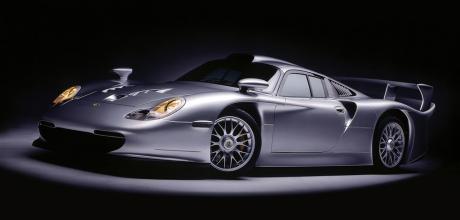1998 Porsche 911 GT1 996
There’s a silver car in front of us that’s completely alien to how we normally consider a 911 to look, yet strangely, some aspects of its aesthetics are recogniseable. This, then, can only be the venerable GT1.
RACER FOR THE ROAD
The one and only mid-eniged road 911 the factory has ever produced is also a behemoth of a supercar
“With the GT1 we say it’s a race car that can be used on the road”
“Where do we start with the 911 GT1 Straßenversion?” we ask on approach to the silver, long-wheelbase behemoth sat at the forefront of our super sextet. “Wow,” says Alexander Klein, curator at the Porsche Museum itself, with a large exhale of breath. “There are many points to start on! So, really, while we say the 997 GT3 RS 4.0 and 2.7 RS are road cars that can be used on track, with the GT1 we say it’s a race car that can be used on the road. This statement is perhaps a little obvious when we look at its size and proportions. However, I’m not sure if it makes sense to drive this on the road. You can’t even open a window, you cannot see anything out of the mirrors, and you need to choose your roads very carefully as it’s very wide and very stiff. A typical winding road through the Black Forest is not the environment for this car!”

There are intrinsic elements of 996-generation 911 styling on this GT1 Straßenversion, though you do have to go looking for them. Aside from the more obvious 996.1 ‘fried egg’ headlights and Carrera rear clusters tucked wistfully under that sweeping rear wing, you’ll notice the GT1’s door handles and front bumper side repeaters are all hallmarks of the first water-cooled Neunelfer, but that’s about it. Everything appears monumentally dissimilar to the 911 enthusiast: the wheelbase has been extended, the roof is much lower, the windscreen shorter, the body longer, with chassis tubes instead of a subframe and, whisper it, that famous silhouette appears to have been swallowed up in the name of extreme grip and aerodynamics. Even the centre-locking wheels on the GT1 were unfamiliar for its time, the technology not appearing on another road-going 911 until a full decade later. Have we mentioned the GT1’s 3.2-litre, twin-turbo flat six is mid-mounted, too?

Obviously, one or two alarm bells may be ringing by now. A quick check of the car’s rear finds clear ‘911 GT1’ lettering between the taillights but, really now, can we call this a true 911? “We absolutely understand it as a Porsche 911,” comes Alexander’s firm response. “The engine is in the right place, for we race our current 991 RSRs with the flat six in the same position. For sure, a 911 is traditionally a rear-engined car, but the GT1 demonstrates the capabilities in performance and engineering possibilities of the 911 platform in its most extreme state. It is for this reason that it had to be included in my top six.”
The GT1 started as a 993 but continued as a 996, with clear evidence of that inside. The steering wheel, dashboard, five dials, gearlever and even seats are all reminiscent of a 993 RS specification, the semi-exposure of the gearlever’s linkage to the gearbox behind a neat nod to its ludicrous Le Mans heritage. Speaking of which, we all fondly remember the GT1 ’98 conquering Le Mans, but the precise number of Straßenversions built remains a mystery. Perhaps Alexander can enlighten us? “It depends whether you count the homologation and works cars as one, but with everything included it’s 21,” he says.

So what was the process for purchasing one of these extreme 911s? “Porsche knew its intended customers in those days and the relationship will have to have been close. Sport drivers are very well known at Porsche. Relationships will likely have been formed as far back as the 1980s with the SC RS and 964 C4 Lightweight, both of which had around 20 cars made. This was likely the process to get into this exclusive group of GT1 ownership,” Mr Klein says, before adding excitedly, “I must say I am very happy to sit so close to this car as 2017 is the 20th anniversary of the GT1’s existence. We’re going to celebrate that this year and plan to bring it back to life on the streets – as it was originally intended [for the road], after all!”
The GT1 is such an impressive car, forming part of the Porsche Museum’s monstrous collection. So, we have one more question for the head of historic cars as we wrap up: just how difficult is it looking after all these precious Porsches? As ever, the answer is as passionate as it is dogmatic. “It’s difficult enough to be a job in its own right! We have 560 cars in our collection, and not just 911s. We don’t just take care of the cars, we keep them alive – we restore them, transport them to events, and use them on track and in rallies. This keeps their story going and although it’s challenging, it’s incredibly rewarding,” says Alexander. Does Mr Klein have the best job in the world? We think so.
TECHNICAL DATA 1998 Porsche 911 GT1 996
- Max Power: 536bhp
- Weight: 1,120kg
- Numbers made: 21
- Years in production: 1996-1998
Above Inside the GT1, the steering wheel, dashboard, five dials, gearlever and even the seats are all reminiscent of a 993 RS specification. Note the 996-generation door handles, however
Below Large intake above cockpit feeds air into the mid-mounted, 3.2-litre flat six engine behind the driver and passenger. Entire rear of carbon kevlar body can be opened with a key in each B-pillar


